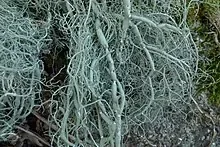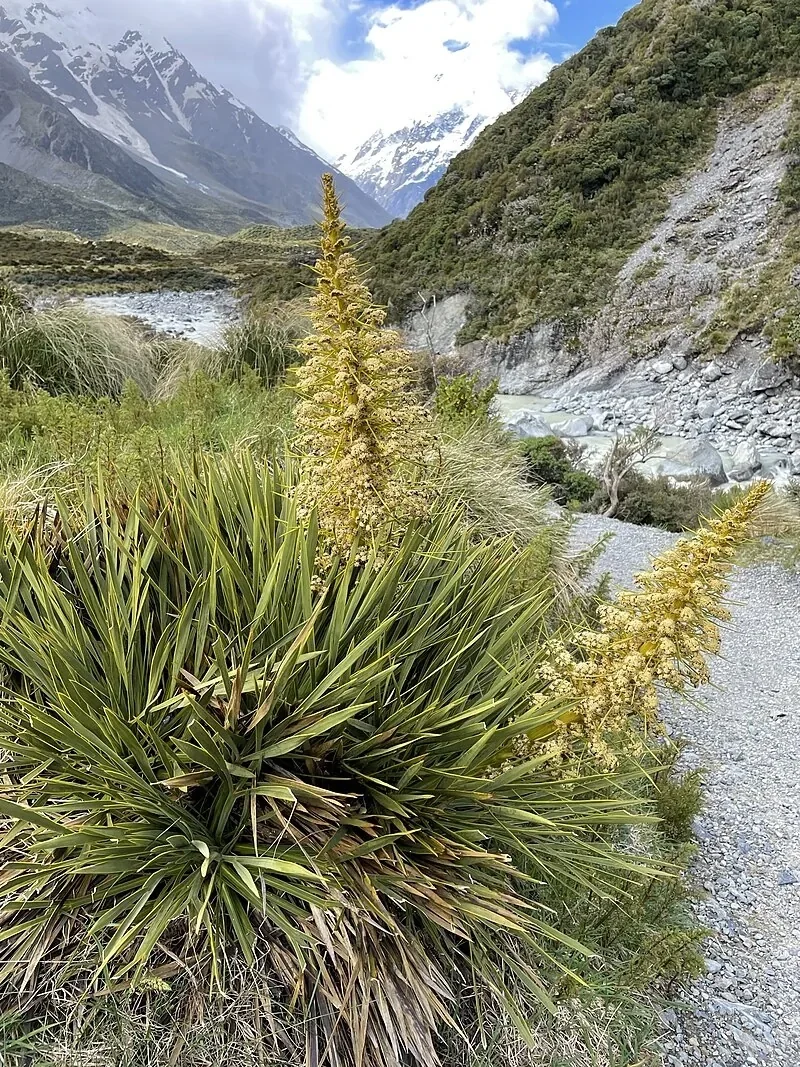
Usnea
Usnea articulata
Introduction
Introduction Overview
Usnea articulata , also known as Old Man's Beard Lichen, is a distinctive lichen native to New Zealand. It is recognized for its long, beard-like strands and its role as an indicator of clean air and healthy forest ecosystems. This fascinating organism is neither plant nor fungus but a symbiotic relationship between algae and fungi. It forms long, hanging strands that resemble a beard, growing primarily on trees in humid forest environments. native trees .

Plant Description
Botanical Features
Usnea ( Usnea articulata ), commonly known as the string-of-sausage lichen, is a distinctive pale greenish-grey, densely branched lichen. Its thallus can grow up to 1 meter in length, often draping over its substratum without a distinct attachment. A key identifying feature of Usnea articulata is its main branches, which are typically 3 mm or more in diameter and are sharply constricted down to the central core, creating an uneven "string of sausages" appearance. The lichen has a very thin cortex and a wide, lax, and cottony medulla. This species commonly festoons well-lit hedges, tree canopies, branches, and twigs, and can also be found on rocks or in sand dunes, favoring open and exposed sites. Usnea articulata is highly sensitive to air pollution, particularly sulphur dioxide, which led to significant declines in its population during the 19th and 20th centuries. However, it is now showing signs of recovery in some areas due to improved air quality. Chemically, its medulla reacts K-, KC-, and Pd+ red.
Quick Facts
Quick Facts Overview
| Scientific Name | Usnea Articulata |
|---|---|
| Height | Strands up to 30 cm (12 in) long |
| Spread | Forms tufts or beards, spreading across branches |
| Water Needs | Requires high humidity; absorbs moisture from air |
| Light | Filtered light to partial shade; avoids direct sun |
| Frost Tolerance | High; tolerates cold, but growth slows in freezing conditions |
| Salt Tolerance | Low; sensitive to salt and air pollution |
| Growth Rate | Slow; growth depends on air quality and humidity |
| Lifespan | Many years if undisturbed in suitable habitat |
Climate Best Suited to
Usnea is native to New Zealand and thrives in the country's diverse climate conditions. It adapts well to various regional climates throughout the country.
Regional Suitability
| City | Climate Suitability |
|---|---|
| Whangārei | Ideal |
| Auckland | Ideal |
| Hamilton | Ideal |
| Tauranga | Ideal |
| Rotorua | Ideal |
| Gisborne | Ideal |
| New Plymouth | Ideal |
| Napier | Ideal |
| Whanganui | Ideal |
| Palmerston North | Ideal |
| Wellington | Ideal |
| Nelson | Ideal |
| Christchurch | Ideal |
| Dunedin | Ideal |
| Invercargill | Ideal |
Natural Habitat
Usnea ( Usnea articulata ), also known as string-of-sausage lichen, is a pale greenish-grey lichen that grows primarily on trees, branches, and twigs, often draping itself over them. It can also be found scrambling over low vegetation in sand dune slacks or, more rarely, on rocks.
Key Habitats Include:
- Epiphytic Growth: It grows as an epiphyte on the bark of trees and shrubs, absorbing moisture and nutrients directly from the atmosphere. It does not harm its host tree but simply uses it as a substrate.
- Well-Lit, Open, and Exposed Sites: This lichen thrives in well-lit, open, and exposed sites, including woodland and moorland.
- Humid Environments: It requires high humidity and good air circulation, which is why it is commonly found in damp, mature forests.
Indicator of Air Quality:
- Air Pollution Sensitivity: Usnea articulata is highly sensitive to air pollution, particularly sulfur dioxide. Its presence is often an indicator of excellent air quality, and its decline or absence can signal deteriorating air quality.
Distribution:
- Widespread (Historically): While it was once widespread, its current distribution is largely restricted to areas with clean air and high humidity. It is found in New Zealand, southeastern Australia, and various other temperate and subtropical regions globally.
The unique growth habit and sensitivity to environmental factors of Usnea articulata underscore its ecological importance as a bio-indicator and its contribution to the biodiversity of healthy forest ecosystems.
Plant Conservation
Usnea articulata , commonly known as the "string-of-sausage lichen," experienced a significant decline during the Industrial Revolution due to its extreme sensitivity to sulphur dioxide pollution. While it is less sensitive to ammonia pollution than some other Usnea species, agricultural intensification has also been tentatively linked to its decline in certain regions. Its primary mode of reproduction is through fragmentation, with a limited ability to recolonize areas due to an apparent absence of spore production. In terms of conservation status, Usnea articulata is classified as Near Threatened (NT) in Britain and is considered an International Responsibility species. In England, it is a Section 41 species, indicating its principal importance for biodiversity conservation. In Wales, it is listed as Vulnerable (VU) and is a Section 7 species under the NERC Act. Despite past declines, there are positive signs of recovery, particularly in South Wales, following reductions in sulphur dioxide pollution. More than 30 new sites for Usnea articulata have been identified in South Wales since 2005, and efforts are underway to monitor its current distribution to track its ongoing increase.
Growing
Substrate
Humidity
Light
- Epiphytic lichen found on trees and shrubs
- Prefers clean air and high humidity
- Sensitive to air pollution
- Does not require soil; absorbs nutrients from the air
Planting Guide
When to Plant
The best time to plant Usnea is during spring or autumn when soil temperatures are moderate and rainfall is reliable.
How to Plant
Dig a hole twice the width of the root ball and slightly deeper. Place Usnea in the hole, backfill with soil, and water thoroughly. Mulch around the base to retain moisture.
Ecological Role
Wildlife Interactions
This plant plays an important ecological role in New Zealand's native ecosystems. It provides habitat and food for native wildlife and contributes to ecosystem health and biodiversity.
Uses and Applications
Practical Applications
Usnea has various practical and ornamental uses. From traditional Māori applications to modern landscaping, this versatile plant serves multiple purposes.
Historically, Usnea was used by Māori for medicinal purposes, food, and cultural practices. These traditional uses reflect the deep knowledge of native plants.
Landscaping Uses
Landscaping Uses Overview
This plant is highly valued in landscaping for its aesthetic appeal and practical benefits. It can be used in various garden styles and landscape applications.
Seasonal Characteristics
Spring
- Period of active growth
- May develop reproductive structures
- Absorbs moisture from spring rains
Summer
- Growth slows during dry periods
- May become dormant in very dry conditions
- Relies on morning dew and humidity
Autumn
- Growth resumes with increased rainfall
- Good time for observation and collection
- Colours may become more vibrant
Winter
- Continues slow growth in mild, wet winters
- Becomes dormant during freezing conditions
- Often most visible when deciduous host trees lose leaves
Pruning and Maintenance
Pruning and Maintenance Overview
Usnea generally requires minimal pruning. Remove dead or damaged growth as needed and shape the plant to maintain desired form. Pruning is best done in late winter or early spring before new growth begins.
How to Grow Usnea
Usnea, also known as Old Man's Beard Lichen, is a distinctive lichen native to New Zealand. It is recognized for its long, beard-like strands and its role as an indicator of clean air and healthy forest ecosystems. This fascinating organism is neither plant nor fungus but a symbiotic relationship between algae and fungi. It forms long, hanging strands that resemble a beard, growing primarily on trees in humid forest environments. Understanding its propagation and conservation is key to supporting this unique species.
Spore Dispersal and Natural Establishment
Usnea articulata , a lichen, is not cultivated in the same way as vascular plants. It is a complex symbiotic organism, consisting of a fungus and an alga, and its growth is intrinsically linked to specific environmental conditions. Therefore, traditional propagation methods such as seed sowing, cuttings, or division are not applicable. Instead, the focus should be on conservation and creating a suitable habitat to encourage its natural establishment. For Usnea to thrive, it requires a specific set of conditions. It is highly sensitive to air pollution, particularly sulfur dioxide, and its presence is often an indicator of excellent air quality. It needs high humidity and good air circulation, which is why it is commonly found in damp, mature forests, away from the direct impact of urban and industrial pollutants. It grows on the bark of trees and shrubs, absorbing moisture and nutrients directly from the atmosphere. It does not harm its host tree, but simply uses it as a substrate to grow on. If you are fortunate enough to have Usnea growing on your property, the best way to "grow" it is to protect its environment. Avoid the use of fungicides, pesticides, and artificial fertilizers in the vicinity of the lichen. Maintain the health of the host trees and the surrounding ecosystem. Any changes to the light, humidity, or air quality can have a negative impact on the lichen's health. Due to its slow growth rate and specific requirements, attempting to transplant or propagate Usnea is often unsuccessful and can damage the delicate organism. The most effective approach is to preserve existing populations and the pristine environments they inhabit.
Pests and Diseases
Common Pests
Usnea is generally resistant to most pests due to its native adaptations. However, it may occasionally be affected by common garden pests such as aphids or scale insects.
Disease Prevention
To prevent diseases, ensure good air circulation around Usnea and avoid overwatering. Remove any diseased plant material promptly to prevent spread.
Cultural Significance
Traditional Uses and Values
While specific cultural significance for Usnea articulata is not widely documented, the Usnea genus, commonly known as "Old Man's Beard" or "Woman's Long Hair," holds various cultural meanings across different societies. Historically, Usnea lichen has been valued in several cultures. In Traditional Chinese Medicine, known as "Songluo," it was used for its cooling properties and to address infections. Native American tribes incorporated it into medicinal preparations, particularly for wounds and respiratory issues, considering it a sacred "herb of the North." European folklore attributed protective attributes to Usnea , believing it could ward off malevolent spirits and ensure good health. Beyond folklore, Usnea has been utilized in traditional herbal medicine globally for its antimicrobial properties. Its unique appearance, often described as hair-like strands dangling from trees, has contributed to its mystical and symbolic interpretations.
Bonus Tip
Usnea articulata , often called 'string-of-sausage lichen,' is a highly sensitive indicator of air quality. Its presence in an ecosystem suggests minimal air pollution, particularly low levels of sulfur dioxide. This makes it a valuable bio-indicator for environmental health, and its decline or absence can signal deteriorating air quality.







